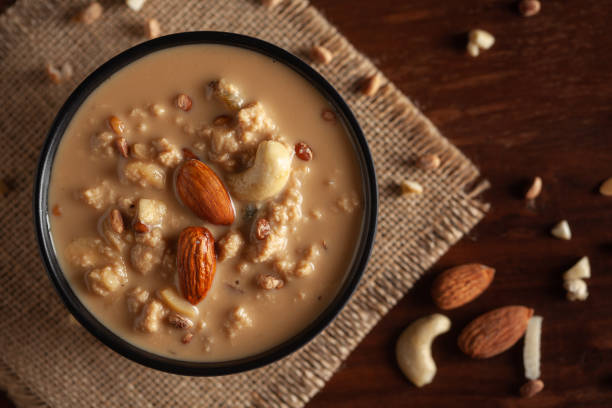There comes a point in life when you should start to question the big things – to probe accepted ideas around religion, politics, and the best way to cook pasta. Forget what you learned at your mother’s knee, what it says on the packet, or what you once heard a celebrity chef say on Saturday Kitchen … or rather, check it for accuracy. As the saying goes, there’s more than one way to crack an egg … but I maintain the most efficient is to tap it against a flat surface and then pull it apart over a bowl. Here are a few other culinary facts that might come as a surprise.
1. Cook pasta in water ‘as salty as the sea’
I admit this notion does have a certain romance – it’s nice to think you’re tasting the Adriatic while eating spaghetti alle vongole in Enfield – but if you’ve ever been smacked in the face by a wave you’ll know that level of saltiness is far too much for human consumption. And while it’s true that most of the salt will disappear down the plughole when you drain the pasta, if you try cooking it at the same level of salinity as the Med, with 38g salt per litre of water, you’ll find it’s still completely unpalatable.
To be fair, those who repeat the claim, like Katie and Giancarlo Caldesi in their book The Long & the Short of Pasta, or even the great food writer Anna del Conte, are usually mistaken about the saltiness of the sea, rather than how to cook pasta, because the Caldesis go on to recommend a mere 5g of salt per litre. Certainly you do need some salt – pasta cooked without it will be bland and disappointing, however delicious the accompanying sauce – but how much depends on your palate.
Del Conte suggests 10g per litre, or at least a teaspoon-worth “if you want a pasta worth eating”, a formula also approved by the Michelin-starred chef Giorgio Locatelli. According to Serious Eats culinary director Daniel Gritzer, 2% is, for him, “the top end of what’s tolerable, tasting very well seasoned but also noticeably salty”.
There’s also debate around whether pasta is best cooked in a very large pan of water, as is traditional, or whether you can save power by using a smaller pot, and less water. I won’t delve into it here, but look up J Kenji López-Alt’s take on the subject on the aforementioned Serious Eats website.
2. Never wash a mushroom
As the US’s Bon Appetit magazine cautioned mushroom-loving readers back in 2017, “If your usual move is to bring them home from the market and immediately stick them under a running faucet – stop! … Dry mushrooms are delicious mushrooms.” It’s almost as if they hadn’t read the very first instalment of what was to become my How to cook the perfect … column back in 2010, where I thoroughly debunked the idea. As I noted back then, Delia Smith, Gordon Ramsay and even the Mushroom Bureau (subsequently rebranded as More with Mushrooms) are also in the no-wash camp, with Smith explaining that fungi “already have a lot of moisture and washing them means they absorb even more, which can make them soggy”.
In fact, though they absorb relatively little water in this process, it turns out any added moisture is a good thing – because, as Dave Arnold of the International Culinary Center observes, “While the mushrooms are boiling off their water, they aren’t absorbing oil. By the time the boiling stops they have already collapsed, so they aren’t as porous as a raw mushroom and don’t want to absorb oil.” Dry mushrooms soak up more oil than wet ones, which, oddly enough, makes them less pleasant to eat. So, in short, stop being lazy and get out the colander.
3. Olive oil is for dressing, not cooking
You’ll often hear that extra virgin olive oil should never be used for high-temperature cooking because it has a relatively low smoke point: 200C (392F), as opposed to sunflower oil’s 225C (437F), or rice bran oil’s 260C (500F). First off, as Prof Tim Spector observes in his latest book Food for Life, unless you’re doing some professional-level stir frying (when the wok should approach 300C) or really cranking up the oven, this is unlikely to be a problem. (Olive oil treated to raise its smoke point is, he says, “highly processed … and best avoided”.)
Second, Spector continues, the high saturated fat content of good quality olive oil makes it more stable when heated at continuous high temperatures (110C/230F) than many vegetable oils, which break into compounds of “unknown health risk” (to say nothing of their effect on a food’s texture and flavour).
Plus, olive oil is rich in polyphenols, with high-grade extra virgin examples containing “at least 30 different antioxidant polyphenols, including tyros, lignans and other flavonoids that appear to have beneficial effects on ageing and inflammation, particularly on the heart and brain”. For these reasons, he writes, “a good extra virgin olive oil is my cooking oil of choice”.
4. Chilli seeds = heat
We’ve all diligently picked out every last fiddly seed from a chilli at the behest of recipes which claim, like those in Floyd on India, that the more you leave in, the hotter the result. In fact, if you remove the seeds from a genuinely piquant pepper, give them a good rinse and put one on your tongue, you’ll discover they taste of very little; the real heat comes from the white membrane that attaches them to the flesh of the chilli, which is the thing you actually need to get rid of if you want the flavour of the fruit without too much of its fire.
5. Never salt pulses in the pan
An object lesson in keeping up to date with your culinary knowledge: in the copy of Delia’s Complete Illustrated Cookery Course that I grew up with, our national treasure writes, apropos pulses, that “perhaps the most important rule is not to add any salt until the end of the cooking” as “salt draws out moistness … and hardens the skin, so even a small amount of salt in the soaking or cooking water will simply retard the process”.
No doubt I’ve dutifully repeated this message over the years – yet in her Complete How to Cook, published in 2009, Smith admits that she now always adds salt during cooking “as it really does give a better flavour … salt never seems to be absorbed properly when added at the end”.
Indeed, food science writer Harold McGee informs readers of his seminal On Food and Cooking that, though salt “does slow the rate at which [pulses] absorb water”, they will still soften, while soaking beans in salted water actually speeds up the cooking time but, he believes, gives a mealier texture – something hotly debated by Joe Yonan, food editor of the Washington Post and author of the book Cool Beans, who always soaks his pulses in salted water … when he soaks them at all. But that’s another story.
6. Tiptoe around a soufflé
With a fearsome reputation as the prima donna of the culinary world, it’s often claimed that the secret to super soufflés is to treat them with kid gloves, whipping as much air into the egg whites as possible before losing no time in folding in the remaining ingredients and getting them in the oven. There must be no sudden movements, no loud noises and God forbid, the likes of Mary Berry and James Martin plead, no opening the oven door until the buzzer goes off!
In fact, once you’ve got as much air in the batter as you can, the rest is pretty much foolproof: the soufflés can be refrigerated for several hours before baking, and as long as the oven is hot, they will rise. Open the door to check on them if you need to: McGee reassures cooks that “the mix can’t fall unless it actually begins to cool down, and even if that did happen, it will rise again when it heats up again”. You’ll still need to rush it to the table before it collapses though; this is cooking, not magic.
7. Always seal your meat
The idea that you can seal the juices into meat by searing the outside has a long history – I find it recommended in the Ladies Home column of the Gloucestershire Chronicle of 11 October 1902. No doubt many disgruntled ladies are now complaining to the editor in the next world, because, though starting meat in a hot pan will help to create a delicious crust, that crust isn’t watertight, as you’ll realise when your carefully seared steak leaks liquid all over the chopping board. The secret to juicy results is, in reality, to let it rest long enough after cooking to reabsorb all that liquid before cutting and serving.
8. Never eat a closed mussel
This advice comes from the same over-anxious place as vastly inflated turkey roasting times – and while in general, I think it’s wiser to err on the side of caution when it comes to food safety, the fact remains that any mussel that can be easily opened should be perfectly safe to eat.
According to Australian marine biologist Nick Ruello: “Extensive cooking tests show that some mussels do not open up even after prolonged cooking and the flesh becomes overcooked. These tests also showed that some mussels which have opened up and [been] removed from cooking have in fact been undercooked. The now common concern about mussels not opening after cooking is therefore misdirected.”
You should, however, treat those with broken shells, or which are gaping open before cooking with a bit more care. Give them a tap, and they’ll most likely close, at least partly. If they don’t, they’re probably dead, so get rid of them, before proceeding with greedy abandon. Take reassurance from the testimony of Spanish seafood blogger Harley Gutiérrez: “Rotten mussels smell incredibly bad. They smell like rotting flesh and seafood. The smell is so strong and pungent that it can be difficult to be near them.” If they’re off, you’ll probably know about it.
9. Fish and red wine don’t mix
Never trust a trigger-happy, emotionally unavailable secret agent with an alcohol problem: not only was James Bond wrong about martinis (they should be stirred, not shaken, unless you actually prefer them more watered down) but in From Russia With Love he claims only a wrong ’un would order chianti with fish. How gauche!
In fact, though 007’s choice of champagne is a better one with the buttery sole, the only fish this prohibition makes sense with are oily species like mackerel and herring, which can react with the tannins in fuller-bodied red wines, like a vintage chianti, to create a metallic aftertaste. The baddie’s dinner may have been overpowered by his choice of wine, but I’d defend his right to enjoy it over Bond’s snobby rules any day.
10. Food should be served piping hot
Whatever TripAdvisor reviewers may believe, a 2007 study by researchers at the University of KU Leuven in Belgium found that our perceptions of flavour decline when eating food above 35C (95F), with sweetness and bitterness becoming more pronounced at the expense of salty and sour notes.
There may be a payoff in terms of texture (which is why fried foods are usually best consumed as hot as you can bear) but all things being equal, most foods will taste of more if they’re allowed to cool down a little before serving. In short, don’t send that taverna moussaka back to be nuked in the microwave; savour the flavour instead.
Article From & Read More ( Never drink red wine with fish! 10 famous food rules you can absolutely ignore - The Guardian )https://ift.tt/hRqHidZ
Entertainment








:max_bytes(150000):strip_icc()/egg-tartine-892cac2657114696ab634792d0bdcb4b.jpg)
